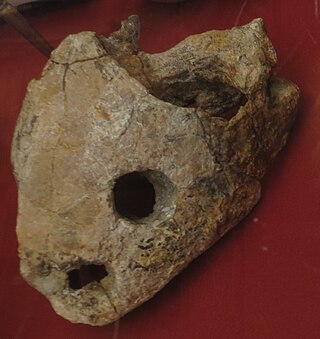
Bothremydidae is an extinct family of side-necked turtles (Pleurodira) known from the Cretaceous and Cenozoic. They are closely related to Podocnemididae, and are amongst the most widely distributed pleurodire groups, with their fossils having been found in Africa, India, the Middle East, Europe, North America and South America. Bothremydids were aquatic turtles with a high morphological diversity, indicative of generalist, molluscivorous, piscivorous and possibly herbivorous grazing diets, with some probably capable of suction feeding. Unlike modern pleurodires, which are exclusively freshwater, bothremydids inhabited freshwater, marine and coastal environments. Their marine habits allowed bothremydids to disperse across oceanic barriers into Europe and North America during the early Late Cretaceous (Cenomanian). The youngest records of the group are indeterminate remains from Saudi Arabia and Oman, dating to the Miocene.

Chupacabrachelys is an extinct genus of bothremydid turtle which existed in western Texas, United States during the late Cretaceous period. Its fossils were discovered in Aguja Formation in the Big Bend region, and its type example is one of the most complete bothremydid specimens known. It was first named by Thomas M. Lehman and Steven L. Wick in 2010 and the type species is Chupacabrachelys complexus. Chupacabrachelys was named after the cryptid of the same name from Mexican folklore.

Foxemys is an extinct genus of bothremydid turtle that was discovered at Fox Amphoux, France and also Hungary and Spain. Its skull and shell structure is similar to Polysternon. Two species are in the genus: F. mechinorum and F. trabanti.

Puentemys is an extinct genus of bothremydid turtle from the Paleocene-age Cerrejón Formation in Colombia. It is the largest known bothremydid, with a shell length of up to 1.51 m (5.0 ft). Puentemys is the only Paleocene bothremydid known from South America, and is most closely related to the genus Foxemys from the Late Cretaceous of Europe, showing that Bothremydini, the tribe of bothremydids to which Puentemys belonged, had a nearly worldwide distribution across the K-T boundary. The ancestors of Puentemys may have reached South America by dispersing across Paleocene coastlines or by riding currents across the Atlantic Ocean.
Chedighaii hutchisoni was a bothremydid turtle that lived during the Late Cretaceous. It was named in 2006 by Gaffney et al. for a specimen, KUVP 14765, consisting only of a skull. The specimen was found in the San Juan Basin of New Mexico in the Hunter Wash Member of the Kirtland Formation. The formation is one of many formations that are from the Kirtlandian land-vertebrate age, and date from 74.0 million years ago. The holotype skull is nearly complete. No skeleton or carapace is known, but the material of "Naiadochelys" ingravata might be assignable to C. hutchisoni.
Bothremys is an extinct genus of bothremydid pleurodiran turtle that was discovered near Gloucester, New Jersey. The genus consists of type species B. cooki, B. arabicus, B. kellyi, and B. maghrebiana.
Araiochelys is an extinct genus of bothremydid pleurodiran turtle that was discovered in the Ouled Abdoun Basin, Morocco. The genus consists solely of type species A. hirayamai.
Inaechelys is an extinct genus of bothremydid pleurodiran turtle that was discovered in the Maria Farinha Formation of Brazil. The genus consists solely of type species I. pernambucensis.
Zolhafah is an extinct genus of bothremydid pleurodiran turtle that was discovered in the Western Desert of Egypt. The genus consists solely of type species Z. bella.
Jainemys is an extinct genus of bothremydid pleurodiran turtle that has been found in the Lameta Formation, India. Originally described by Sohan Lal Jain in 1977 under the name "Carteremys" pisdurensis, the species was transferred to the new genus Jainemys by Joyce & Bandyopadhyay in 2020.
Ilatardia is an extinct genus of bothremydid pleurodiran turtle that was discovered in the Farin Doutchi Formation of Niger. The genus consists solely of type species I. cetiotesta.
Azabbaremys is an extinct genus of bothremydid pleurodiran turtle that was discovered in the Teberemt Formation of Mali. It was described in 2001, based on a skull that had been recovered in an expedition in 1981. The genus consists solely of the type species Azabbaremys moragjonesi. The genus name is derived from Azabbar, a monster in Tamasheq folk stories. The species is named for Morag Jones, a research student who participated in the discovery of the specimen and died in the expedition. Azabbaremys is most closely related to another Paleocene side-necked turtle, Acleistochelys.
Eotaphrosphys is an extinct genus of bothremydid pleurodiran turtle that was discovered in the Mont Aime Formation, France. Originally assigned to the genus "Tretosternum", it consists exclusively of type species E. ambiguum.
Taphrosphys is an extinct genus of bothremydid pleurodiran turtle that was discovered Angola, Morocco and the United States. The genus consists of type species Platemys sulcatus, T. ippolitoi, T. congolensis, and the dubious T. dares.
Phosphatochelys is an extinct genus of bothremydid pleurodiran turtle that was discovered near Oued Zem, Morocco. The genus consists solely of type species P. tedfordi.
Rhothonemys is an extinct genus of bothremydid pleurodiran turtle that was discovered in the Paleogene of Morocco. The genus consists solely of type species R. brinkmani.
Ummulisani is an extinct genus of bothremydid pleurodiran turtle that was discovered in the Eocene of Morocco. The genus consists solely of type species U. rutgersensis.
Labrostochelys is an extinct genus of bothremydid pleurodiran turtle that was discovered in the Ouled Abdoun Basin, Morocco. The genus consists solely of type species L. galkini.

Nigeremys is an extinct genus of bothremydid pleurodiran turtle from Niger, Mali and Syria. The genus consists exclusively of the combinatio nova of the type species N. gigantea.
Sindhochelys is a genus of extinct turtle of the family Bothremydidae. It lived during the early Paleocene in what is known Sindh, Pakistan. The genus was discovered in the Khadro Formation and named in December 2021. The genus represents the first known member of its family in Pakistan. The family Bothremydidae lived from the Cenomanian of the early Cretaceous to the Miocene epoch.




